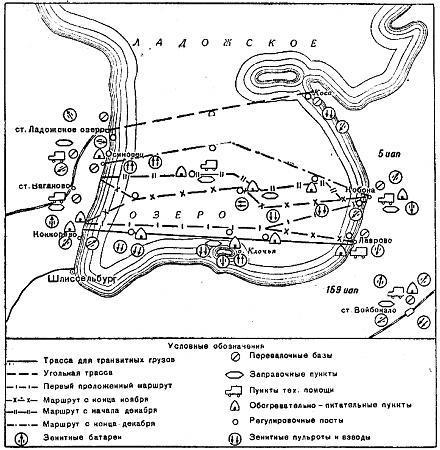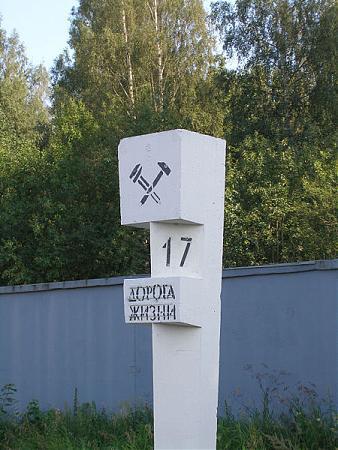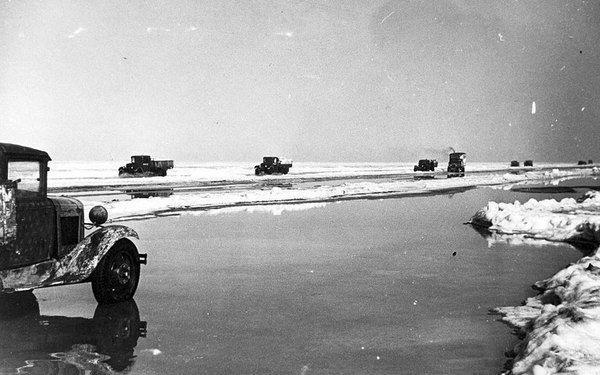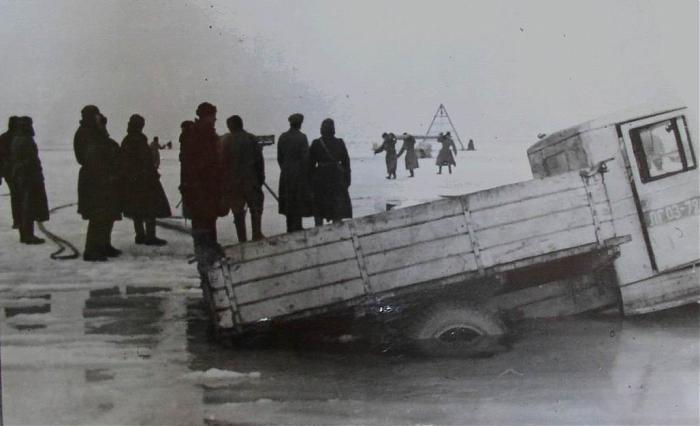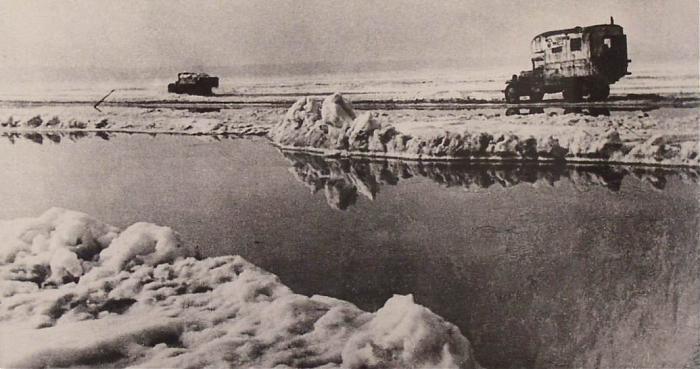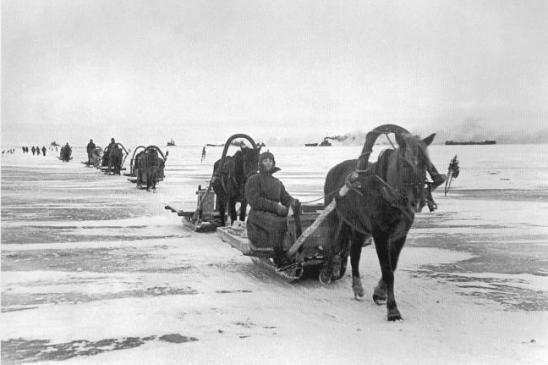The Road of Life was the ice road winter transport route across the frozen Lake Ladoga, which provided the only access to the besieged city of Leningrad while the perimeter in the siege was maintained by the German Army Group North and the Finnish Defence Forces. The siege lasted for 29 months from 8 September 1941, to 27 January 1944. Over one million citizens of Leningrad died from starvation, stress, exposure and bombardments. Each winter, the Lake Ladoga ice route was reconstructed by hand, and built according to precise arithmetic calculations depending on traffic volume. In addition to transporting thousands of tons of munitions and food supplies each year, the Road of Life also served as the primary evacuation route for the millions of Soviets trapped within the starving city. The road today forms part of the World Heritage Site.
Establishment
By 8 September 1941, the German Army Group North under Feldmarschall Wilhelm Ritter von Leeb had almost completely surrounded Leningrad, successfully cutting off all major supply routes. To address this growing concern, a decision was cast by the Military Soviet of the Leningrad Front to establish an evacuation commission in November 1941. As the severity of the siege intensified, the committee proposed the construction of an ice road over Lake Ladoga as both a viable supply line and means for civilian evacuation en masse. The Road of Life began to operate on 19 November 1941 after Captain Mikhail Murov and his transport regiment carried the first supplies over Lake Ladoga via horse-drawn sleigh. However, due to proximal bombardments, ice breakage, and unreliable machinery, the route was far from fully functional at this time. It was only in mid-December, after troops of the Volkhov front recaptured Tikhvin, that construction of a railroad directly connecting the western shore of Lake Ladoga to Leningrad was possible.
Shortly thereafter, the ice road began receiving truck traffic, despite frequent breaks in the early stages of the ice. The route was so dangerous, that in the first week of truck operation alone, more than forty supply trucks had fallen through the ice and sunk to the bottom of the lake – a frozen depth of 700 feet at its deepest point. After sustaining massive initial supply losses in November and December, the Road of Life slowly began to show signs of improvement by January and February 1942, thanks to the completion of a rail line connecting the ice road to Voibokalo.
During the winter of 1941–42 the ice corridor of the Road of Life operated for 152 days, until 24 April. About 514,000 city inhabitants, 35,000 wounded soldiers, industrial equipment from 86 plants and factories, and also some art and museum collections were evacuated from Leningrad during the first winter of the blockade. While the road was protected by anti-aircraft artillery on the ice and fighter planes in the air, truck convoys were constantly attacked by German artillery and airplanes, making travel dangerous.
The Finnish forces intentionally left the supply route open in tacit defiance of Germany's requests.
The total number of people evacuated from the siege of Leningrad through the Road of Life was about 1.3 million, mostly women and children.
During 1942 the "Artery of Life", a 29 km long oil pipeline via Lake Ladoga was built of which 21 km ran under water at a depth of 12.5 metres.
During the following winter of 1942 - 1943, the Road of Life began to operate once again, starting with horse traffic on 20 December 1942. Motor vehicles began to operate on 24 December 1942. Construction of the 30 km long railway over piles and ice also began in December 1942.
Operation Spark - a full-scale offensive of troops of the Leningrad and Volkhov Fronts - started in the morning of 12 January 1943. After heavy and fierce battles, the Red Army units overcame the powerful German fortified zones to the south of Lake Ladoga, and on 18 January 1943 the two fronts met, opening a land corridor to the besieged city. Almost immediately, both truck and rail traffic began to bring supplies to Leningrad.
The city of Leningrad was still subject to at least a partial siege, as well as air and artillery bombardment, until a Soviet offensive broke through the German lines, lifting the siege on 27 January 1944.
For the heroic resistance of its citizens, Leningrad was the first city awarded the honorary title of Hero City in 1945.
Construction
Measuring 219 km in length and 138 km wide, Lake Ladoga is one of Europe’s largest lakes of its kind. Due to its size and unpredictable weather conditions, many speculated that the construction of an ice road connecting its shores would be impossible.
Although the Russians had previous historical experience in ice road construction, none of their prior endeavors were as complicated or as urgent as the Ladoga supply route. Even during winter, the region’s erratic winds were capable of increasing or decreasing the lake’s water level by as much as four feet within just a few hours. A team of engineers was quickly assembled to ensure that the proposed 48 km route would be structurally sound.
Once the route had been confirmed and tested for stability, larger plows and snow carving machines were then used to widen the ice road and make it more suitable for automobile transport. By February 1942, large snow banks on either side of the route had been made into massive ice walls, which shielded transport from the lake’s harsh winds. At each kilometer, a traffic guard flagged the convoy onward, and warned of obstructions or accidents ahead. As the ice melted in the spring, the ice road was dissolved and replaced with a flotilla system that continued to ferry goods across the massive lake.
As soon as the ice hardened, the Road of Life was reconstructed again in the winter of 1942, and once more in the following winter of 1943.
After the siege
In the summer, with the start of the navigable period, deliveries to the city continued thanks to the Ladoga Military Flotilla. In 1943 the Road of Life was replaced by the Road of Victory – a railway, laid on the narrow path conquered during operation Iskra from Leningrad to Volkhov. Now the Road of Life, within the limits of Saint Petersburg, is often referred to as Ryabovskoe Highway, but within Vsevolozhsk, the Road of Life is the official name.

